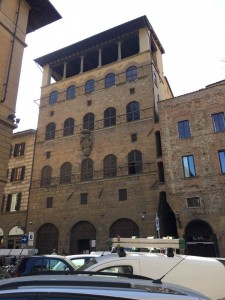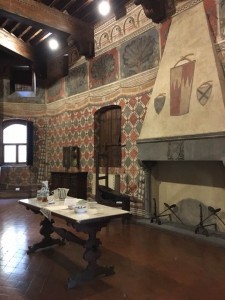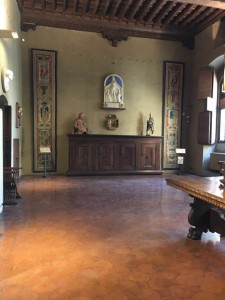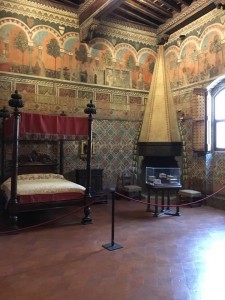Palazzo Davanzati
By: Rachyl Grussing (Istituto Lorenzo de’ Medici)
Situated a stone’s throw from the Ponte Vecchio and the Porcellino Market, Palazzo Davanzati is a fine example of an early Renaissance building. Purchased by the Davanzati family in 1578, the house stayed in the family for almost 300 years. After being turned into apartments, and then a historic house museum by Elia Volpi, Palazzo Davanzati finally came to the Italian State in 1951, where it was reorganized and opened to the public in 1956.
The Palazzo functions as a quasi-immersive experience. Furniture from the 13th through 19th century has been purchased to give the Palazzo the feel of an authentic Renaissance dwelling. There are no large panels in any of the rooms, nor are there labels on the works of art scattered throughout the space. Rather, there are small stands which feature information about the paintings, and also offer a single page cardboard document which explains, in english and italian, the purpose of the room and some small information about the history of the space and the items inside. There are also small stands with screens on each floor, however, they do not work.
These things attempt to give the impression of stepping into an early Renaissance era room. Each floor is ascended one by one, and only with a guide accompanying the visitors. The labels on each floor are informative, but they leave the visitor wishing for more information. For example, there are exquisite remnants of graffiti on every floor, in almost every room. The didactic materials mention when the graffiti was possibly made, but what could be exploited as a fascinating and engaging element of the history of the house is sadly left to a few lines on cardboard. The frescos of the bedrooms are incredibly well preserved, filled with symbolism and history, but are regulated to paragraphs on the didactic materials. The same mentality seems to permeate the entirety of the house.
With such a rich history and occupying an important place in the development of the Renaissance style houses, Palazzo Davanzati should use the resources at its disposal to create educational materials and events that show the exquisite nature of the home. Instead of simple single page of text to explain the home, the Palazzo could invest in more working technology to offer in depth information to the visitor. With even a small increase in the didactic materials the visitor would experience the Palazzo as more than a simple aesthetic experience, sprinkled with a few facts, but would instead create an atmosphere of understanding and appreciation.
Traduzione di Tania Mio Bertolo (Università degli Studi di Firenze)
Situato a pochi passi da Ponte Vecchio e dal Mercato del Porcellino, Palazzo Davanzati è un buon esemplare di struttura architettonica risalente al primo Rinascimento. Acquistato dalla famiglia Davanzati nel 1578, il palazzo appartenne alla stessa dinastia per oltre 300 anni. Dopo esser stato riadattato in appartamenti, ed in seguito allestito a museo da Elia Volpi, nel 1951 il palazzo divenne proprietà dello Stato e fu aperto al pubblico, dopo un’ulteriore riorganizzazione, nel 1956. L’allestimento del palazzo offre un’esperienza quasi immersiva. Mobili risalenti al periodo compreso tra i secoli XIII e XIX sono stati acquistati per dare al palazzo l’aspetto di un’autentica dimora rinascimentale. Non vi sono né grandi pannelli informativi nelle sale, nè cartellini didascalici accanto alle opere d’arte distribuite nel percorso espositivo. Vi sono invece piccoli supporti esplicativi che forniscono informazioni circa i dipinti esposti e che mettono a disposizione del visitatore cartoncini documentari, redatti sia in italiano che in inglese, funzionali ad esporre e l’obiettivo tematico di ciascuna sala, e il carattere storico degli spazi espositivi e degli oggetti in mostra. In ciascun piano è collocato uno schermo informativo, ahimè non funzionante.
Nel complesso, ogni elemento concorre a creare l’illusione di trovarsi realmente in uno spazio abitativo del primo Rinascimento. Il percorso museale, possibile solo con la guida di accompagnamento, attraversa ogni livello del palazzo. Le informazioni fornite in ciascun piano, benchè utili, non sono esaustive, e lasciano purtroppo al visitatore il desiderio di saperne di più. Per fare un esempio: quasi in ogni sala del museo il visitatore si imbatte in squisiti frammenti di graffiti, rispetto ai quali le targhette didascaliche suggeriscono la possibile epoca di realizzazione, ma mancano purtroppo di riferirne l’uso quali affascinanti ed attraenti elementi del contesto storico della dimora, aspetto al quale sono tristemente dedicate poche parole nel cartoncino già menzionato. Ancora: nelle camere da letto vi sono alcuni affreschi magnificamente conservati, ricchi di simboli ed elementi storici, la descrizione dei quali è però relegata a piccoli paragrafi nei materiali didattici. La stessa dinamica sembra permeare la casa nel suo intero.
Con un passato storico così ricco e con un ruolo così importante come testimonianza dello sviluppo dell’arredo nelle dimore rinascimentali, il Museo di Palazzo Davanzati dovrebbe utilizzare le risorse di cui dispone per redigere materiali educativi ed eventi aperti al pubblico finalizzati a mostrare la squisita natura di questa dimora. Al posto di semplici singole pagine di testo descrittive, il museo dovrebe investire negli strumenti tecnologici per offrire maggiori informazioni al visitatore. Anche solo con un piccolo incremento del materiale didattico, il visitatore sarebbe messo nella condizione di attraversare il Palazzo percependolo non più soltanto come un’esperienza estetica intervallata da esigue informazioni, ma come un’opportunità di conoscenza e crescita culturale.



